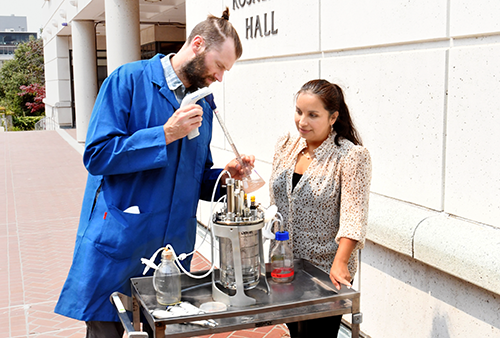Engineering a Hungry Bacterium to Protect Public Health
Most of the 17 “rare earth elements” can be found near the bottom of the periodic table, but none of them can be found in our bodies -- with one brief exception. The rare earth element gadolinium is the key ingredient in contrast agents used to improve detail in MRI images.

Gadolinium is harmless if it is bound up in the contrast agent compound. But as the compound breaks down, gadolinium toxicity becomes a threat.
New strategies under development could chemically cloak gadolinium and speed its elimination from the body. <See research profile of current Bakar Fellow Rebecca Abergel, “Removing A Potential MRI Risk – Literally”>. But safety concerns would remain. Gadolinium returns to its toxic state in medical waste and can make its way into the water supply.
Microbiologist Cecilia Martinez-Gomez studies a widespread specie of bacteria that thrives on rare earth elements, also known as rare earth metals or lanthanides. She has engineered one strain of the bacteria to efficiently accumulate a rare earth element known as neodymium from electronics waste and recycle it back to the industry for making batteries, speakers, even jet turbines.
Martinez-Gomez aims to adapt the microbe to remove gadolinium from medical waste and recycle it for production of new MRI contrast agents. A win-win for health safety and manufacturing.
She discusses the bacterium, known as Methylorubrum extorquens, and the technology she is developing with her Bakar Fellows support.
Q. First off, where are these metal-mining bacteria normally found?
A. They’re very common. They are suspended in the air all around us. They live in the soil, and they’re abundant on leaf surfaces. They’re part of the chemistry of respiration on plant leaves.
Q. How did you get involved in using them to extract valuable metals?

A. I am a microbial physiologist, so I care about metabolic pathways in bacteria. Seven years ago, it was reported that a microorganism like the one we study uses rare earth elements in its metabolism. I became fascinated with understanding how they do this. I wanted to figure it out.
I realized that I was in a very privileged position. The field was completely open and unknown. We wanted to study the bacteria’s basic biology and apply this to develop a method to extract neodymium.
Now we are focusing on gadolinium. There’s no current technology to remove it from its toxic state in medical waste. Once it gets into groundwater, it becomes diluted and we don’t have technologies that are sensitive and efficient enough to recover it. Our goal is to prevent it from getting into the environment in the first place.
Q. How do the bacteria gain access to these metals?
A. We’ve learned that the bacteria excrete what we call lanthanophore molecules that can grab onto the metal so it can be transported into the cell. We engineering our bacteria to produce more lanthanophores and maximize their ability to bring in the gadolinium – what I call a ‘life metal.’ It’s really incredible how they do it.
Q. What role do the metals play inside the cells?
A. We know that when rare earth elements are in the bacteria’s environment, they are brought inside the cell. Once inside, the rare earth elements act as a signal that turns on some genes and turns others off. The rare earth elements also bind to specific enzymes, allowing them to function, and these enzymes are important for the bacteria’s survival. The rare earth elements are even stored in the bacteria as granules that are saved for later use if they happen to find themselves in a situation where they can’t find the metals in the environment any longer.
Q. How do you plan to extract gadolinium?
A. We have isolated a genetic variant of our bacteria that can acquire gadolinium, a rare earth element the bacteria normally cannot use. This variant strain accumulates gadolinium very selectively and efficiently. We know that the process is highly regulated by certain proteins, and we are manipulating the bacteria’s access to those proteins. We are directing their evolution to become more efficient so that we can recover gadolinium from diluted sources like wastewater.
Q. What are your next steps with the Bakar support?
A. Urine in medical waste has chemical properties that are foreign to these microbes. For example, urine can be acidic, and the bacteria normally grow in neutral pH. But there are cousins of this bacterium that grow well in acidic environments. We have ideas on how to genetically modify our bacteria so that they can grow well in these new conditions.
We are also becoming educated about working with industry. I had a meeting today to consider what to look for in a commercial partner. And through the program we are getting advice that is particular to our situation. I think we’re going to be able develop a cost-effective, environmentally friendly, one-step process to clean water contaminated with gadolinium and recycle that gadolinium for the production of MRI contrast agents and likely other products as well.
The Bakar Fellows Program supports innovative research by early career faculty at UC Berkeley with a special focus on projects that hold commercial promise. For more information, see http://bakarfellows.berkeley.edu.
